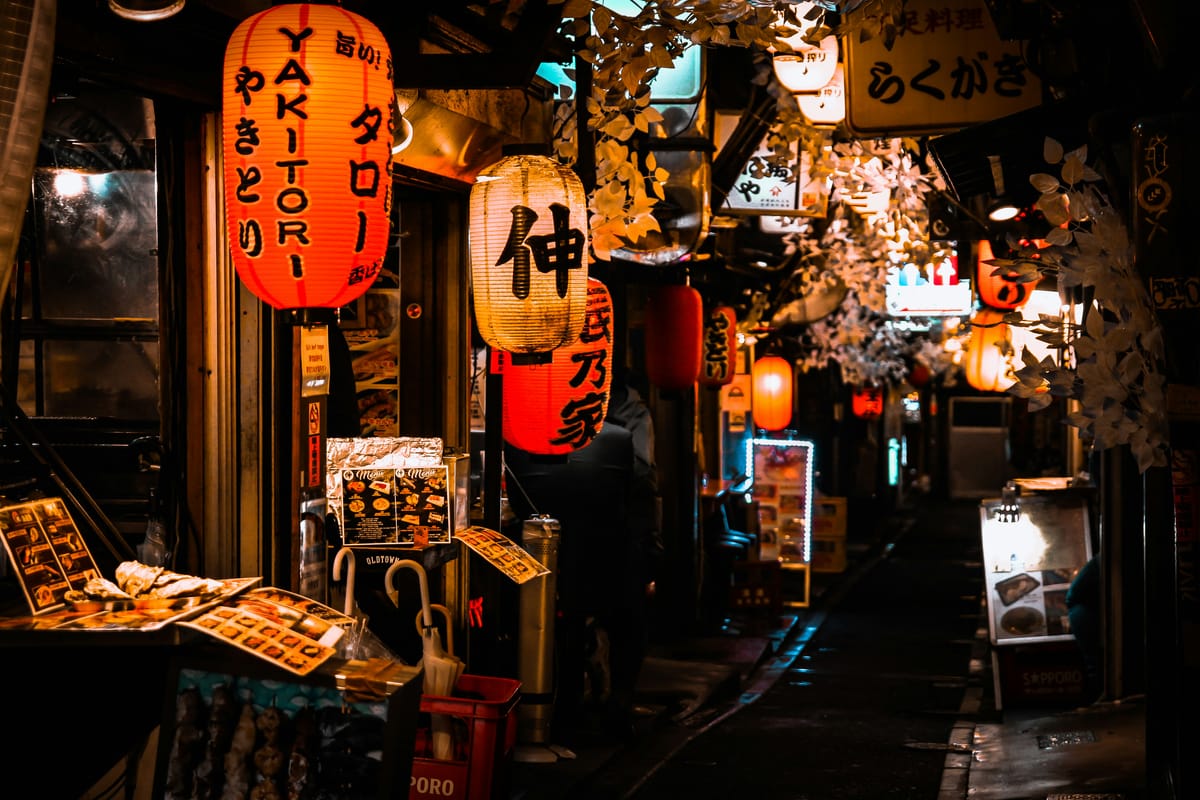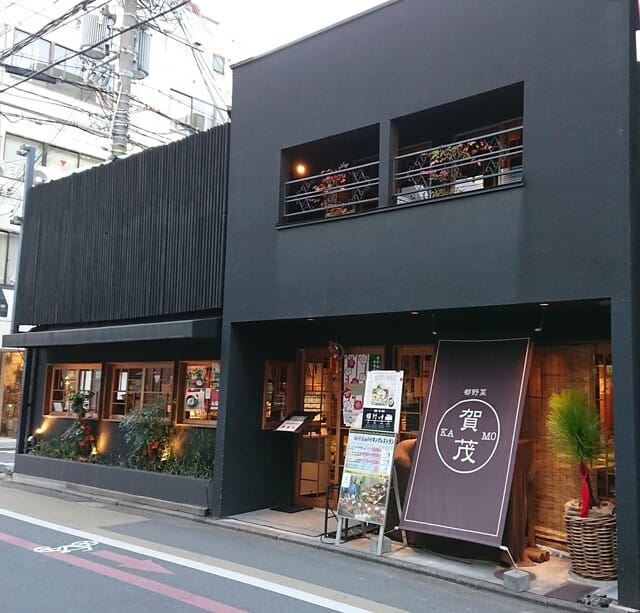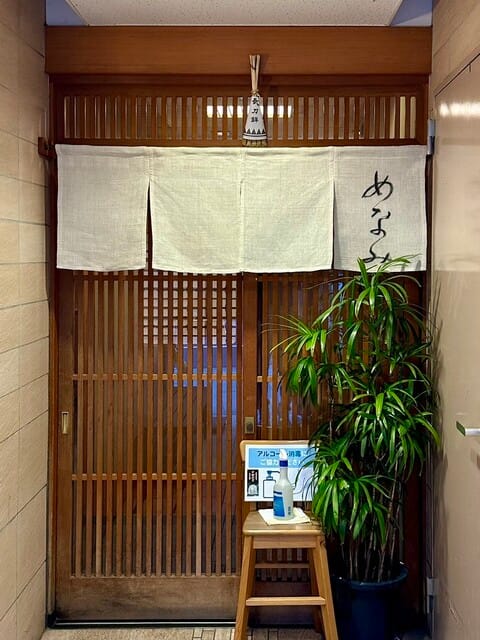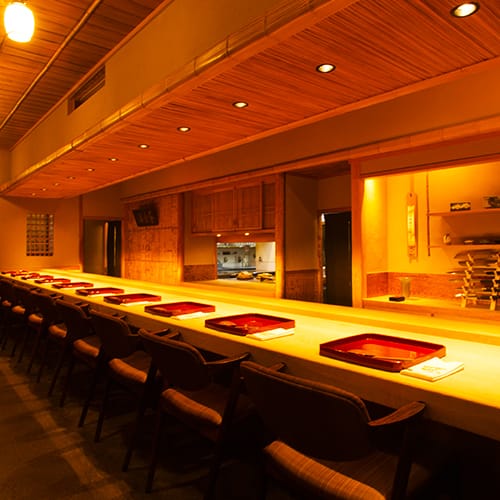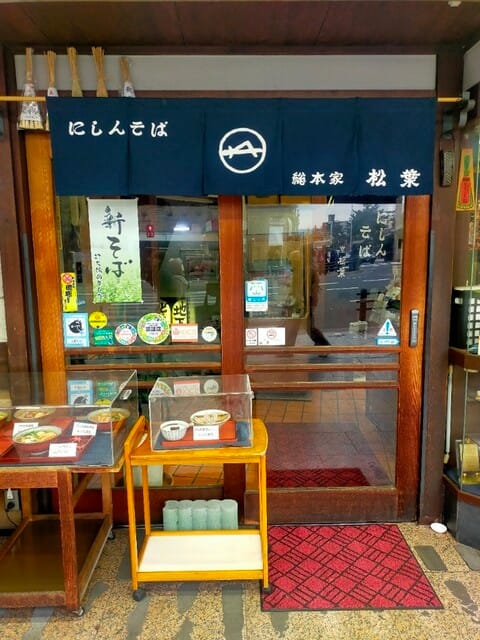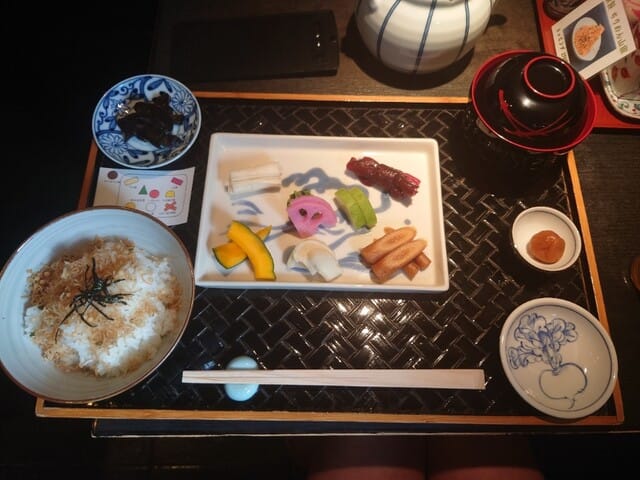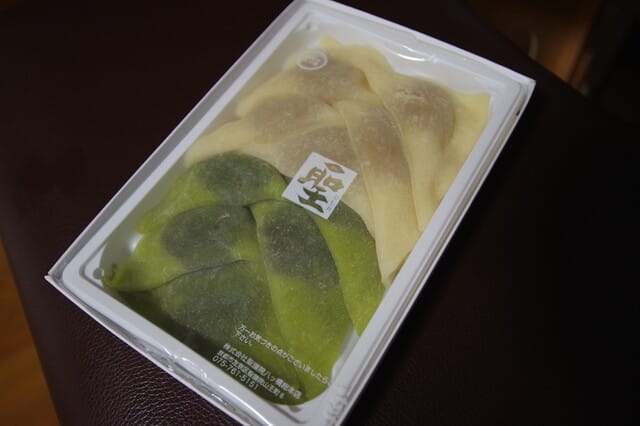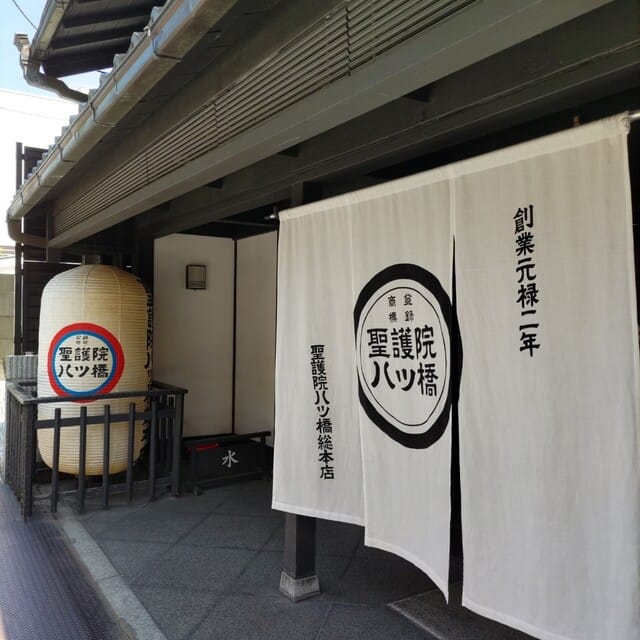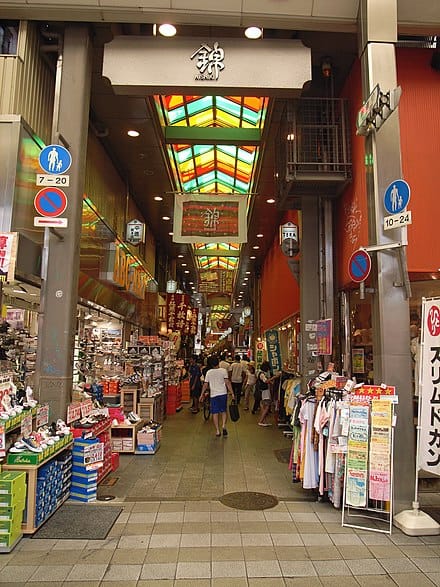Kyoto was the capital of Japan until the Edo period about 500 years ago, and it's still a city where many traditional streetscapes remain as the "old capital of Japan."
During the time when Kyoto was the capital, the imperial family ruled Japan. Therefore, Kyoto's food culture strongly reflects the food culture of the aristocracy.
As cuisine for the nobility, luxurious and delicate-looking dishes developed in Kyoto. Now, these dishes are called "Kyo ryouri" and have become something that locals eat on special days.
Another characteristic of Kyoto is the development of vegetable-centered dishes that don't use meat or fish, reflecting Buddhist philosophy. Kyoto's abundant vegetable dishes are incorporated not only in high-class "Kyo ryouri" but also in "obanzai," which common people eat at home.
During my time as a graduate student in Kyoto, I became obsessed with this city's rich food culture steeped in history. I not only enjoyed obanzai buffets many times but also have fond memories of eating high-class Kyo ryouri to celebrate my graduation.
I also learned that there are many local and traditional foods unique to Kyoto, such as nishin soba, Kyoto pickles, and Kyoto sweets, and I realized the diversity and depth of this city's food culture.
In this article, I'll introduce the food culture unique to Kyoto in detail, drawing on my experiences. From the sophistication of Kyo ryouri to the homely flavors of obanzai, I hope to convey the essence of Kyoto's food culture without omission.
When you visit Kyoto, please use this guide to fill your heart with Kyoto food!

This guide comprehensively introduces the appeal of Kyoto's food. If you want to see specific information, please use the table of contents below.
Table of Contents
・The Appeal of Kyoto's Food Culture
・The Appeal of Obanzai and Representative Dishes
・Characteristics of Kyo ryouri and Representative Dishes
・Hidden Kyoto Foods Loved by Locals
・The Charm of Kyoto's Nishiki Market
・Frequently Asked Questions About Kyoto Food
The Appeal of Kyoto's Food Culture
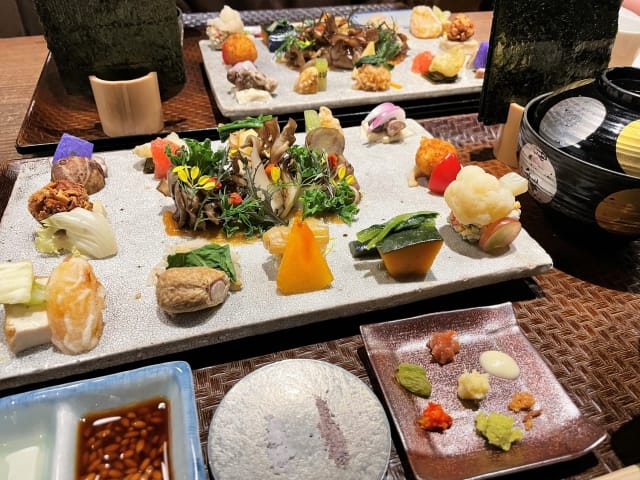
Kyoto's food culture has a unique charm unlike any other. First, the selection of seasonal ingredients that harmonize with Kyoto's natural beauty in each season is characteristic. By using seasonal ingredients, you can enjoy flavors unique to that time of year.
Also, as represented by Kyo ryouri, delicate and elegant seasoning and visually beautiful plating techniques are a big attraction of Kyoto's food culture. I think both taste and appearance are equally important in the Kyoto style.
And the traditional dining styles cultivated over a long history, such as tea ceremony and kaiseki cuisine, are also unique to Kyoto. Kyo ryouri can be enjoyed not just by eating, but by feeling the meaning and aesthetics embedded in it.
Supporting such Kyoto food culture is the existence of unique food cultures like Kyo ryouri and obanzai. Furthermore, the use of abundant and high-quality local ingredients, including Kyoto vegetables, is essential.
I'm attracted to Kyoto's food because all of these are cultures rooted in the land of Kyoto. I think this food culture, which maximizes ingredients nurtured by the climate with the wisdom and techniques of our predecessors, truly embodies Kyoto itself.
The Appeal of Obanzai and Representative Dishes
"Obanzai" is one of the representative foods of Kyoto, and it's also a dish that I absolutely want travelers to try.
First, let me introduce the appeal of obanzai.
The Appeal of Obanzai
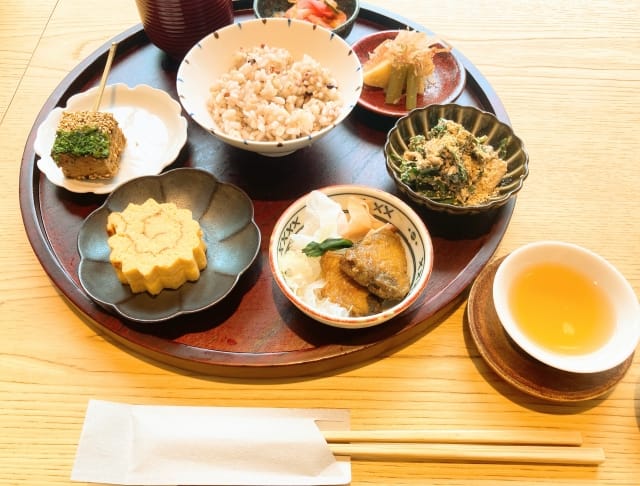
While "Kyo ryouri" is high-class cuisine, obanzai is more popular cuisine familiar as Kyoto's home cooking. It's characterized by simple and flavorful seasoning, and its homely and everyday atmosphere is attractive.
Obanzai is also pleasing because it consists of a nutritionally balanced menu centered on seasonal vegetables. A table set with one soup and three side dishes, colorfully arranged in small bowls, is enjoyable just to look at.
And above all, obanzai is set at affordable prices, so you can easily enjoy the taste of Kyoto homes. In fact, obanzai buffet restaurants have recently become popular in Kyoto.
The charm of obanzai specialty stores is the selection of ingredients and recipes unique to Kyoto, using Kyoto vegetables. You can enjoy healthy and somewhat nostalgic flavors that use plenty of local seasonal vegetables.
I love the unpretentious, simple taste of obanzai. When I stay in Kyoto, I always choose a hotel that serves obanzai breakfast.
Representative Obanzai Dishes
There are quite a lot of types of obanzai, so here I'll introduce particularly representative foods.
Agedashi Tofu
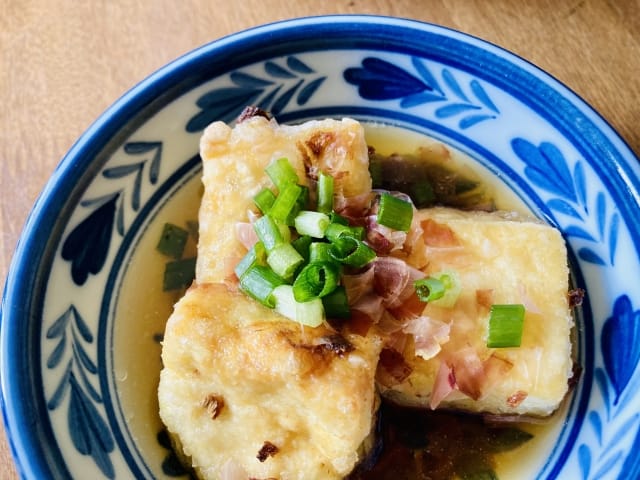
Agedashi tofu is a dish where silken tofu is fried, topped with dashi broth, and served with grated ginger and daikon radish. The dashi is carefully made from ingredients like kelp, bonito flakes, and dried sardines, resulting in an elegant flavor.
Adding grated ginger and daikon radish gives it a refreshing aftertaste. By frying the tofu, you can enjoy a crispy exterior and soft interior texture. It's popular not only as Kyoto home cooking but also as an izakaya menu item.
Especially in the cold winter season, eating warm agedashi tofu warms you up from the core of your body. The gentle flavor warms both your heart and body. I think it's a staple winter dish in Kyoto.
Nimono (Simmered Dishes)
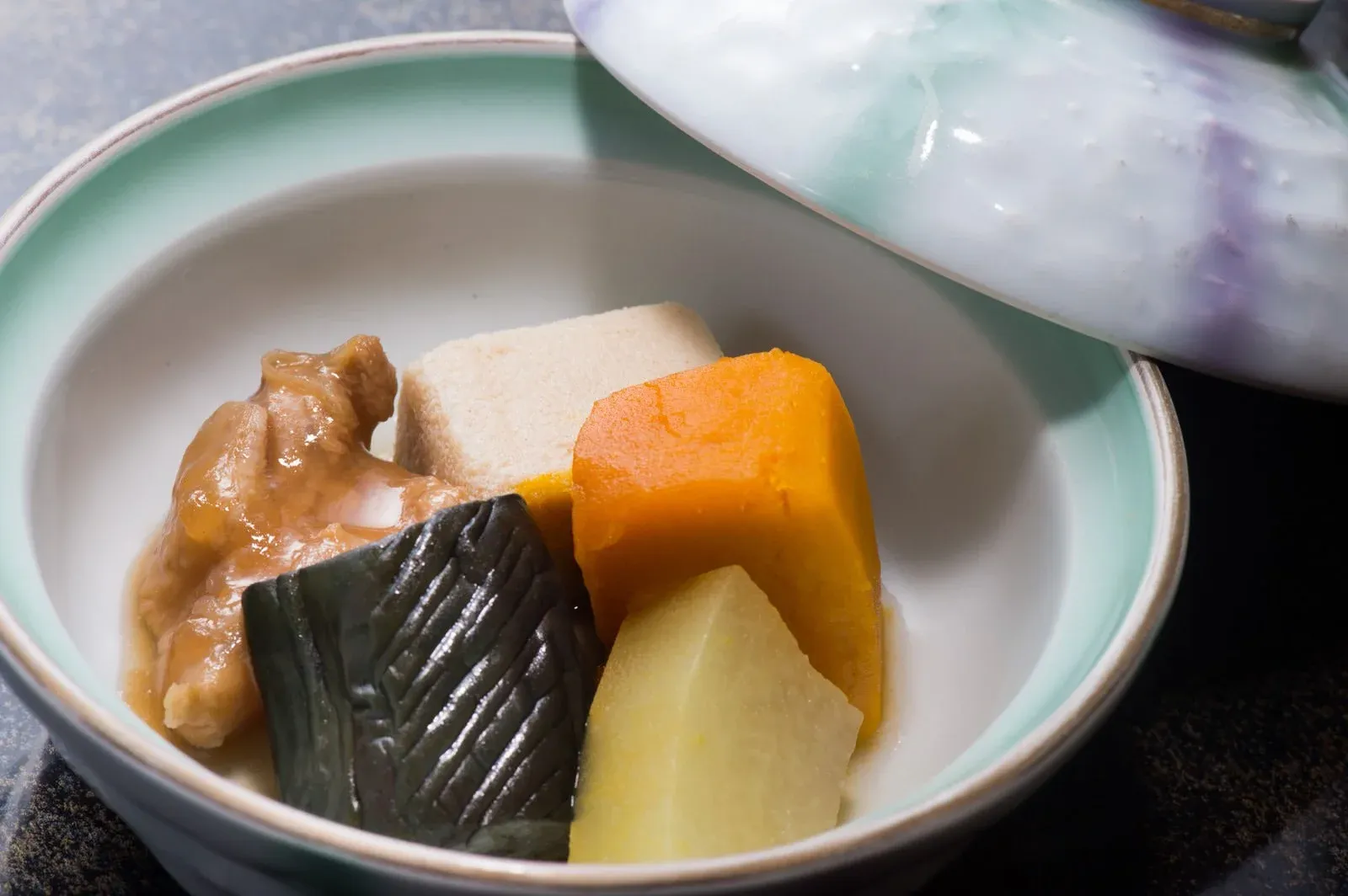
Nimono, or simmered dishes, are dishes where root vegetables and konjac are simmered in gently seasoned dashi. The ingredients used include lotus root, taro, carrots, burdock root, shiitake mushrooms, and konjac. These are seasoned with miso, soy sauce, sake, mirin, etc., and slowly simmered.
During the simmering process, the umami of the vegetables dissolves into the dashi, resulting in a gentle flavor. To enjoy the texture of the ingredients, vegetables are generally cut into larger pieces. The vegetables that have absorbed the flavors have an indescribably delicious, soft and fluffy texture.
Nimono, packed with vegetables, is a healthy and well-balanced dish. I think it represents the taste of Kyoto homes.
Dashimaki Tamago

Dashimaki tamago is a fluffy rolled omelette made with added dashi. Adding dashi to the egg mixture results in a deeper flavor. The dashi is carefully made from ingredients like bonito flakes, kelp, and dried sardines, characterized by an elegant Kyoto-like flavor.
It's made using a technique of rolling thin layers of egg, so it's also a visually beautiful dish. The fluffy texture and moist mouthfeel are attractive. It's popular as a staple bento side dish not only in Kyoto but throughout Japan.
Recommended Shops to Enjoy Obanzai
If you want to eat obanzai in Kyoto, I recommend visiting the following shops that I often go to.
Miyako Yasai Kamo
Source: Tabelog by Miyako Yasai Kamo
Miyako Yasai Kamo is a buffet-style restaurant that mainly serves fresh vegetables grown in Kyoto. You can enjoy healthy and delicious obanzai dishes using organic or reduced-pesticide vegetables.
It's so popular that I can say it's the first place to go for an obanzai specialty store. In addition to Karasuma and Kyoto Station, there's also a shop at JR Osaka Station, so access is convenient.
At Miyako Yasai Kamo, I'm happy that I can eat a lot of Kyoto vegetables. Not only can you fully enjoy the taste of fresh vegetables, but it's also attractive that there's a balanced, healthy menu. I'd definitely recommend this shop to those who want to savor the deliciousness of Kyoto vegetables.
Website: https://nasukamo.net/
Menami
Source: Tabelog by Julien
Menami is an izakaya-type shop where you can enjoy obanzai and sake in a Kyoto-like atmosphere. The obanzai assortment is about 1,500 yen, which is a good deal, making it perfect for snacks with drinks. It's also nice that it's accessible, just a 3-minute walk from Keihan Sanjo Station.
When I visited Menami, I sat at the counter and had a lively conversation about obanzai with the owner. It's a good memory that I heard interesting stories about local vegetables and cooking methods. It was a wonderful night where I felt the warmth of Kyoto in the gently seasoned obanzai.
<Store Information>
Address: 1F SANJO KIYAMACHI BLD. Ⅱ, 96 Nakajimacho, Nakagyo Ward, Kyoto 604-8004
Closed: Wednesdays
Phone: 075-231-1095
Hours: 3 PM–9:30 PM
Website: http://www.menami.jp/
Characteristics of Kyo ryouri and Representative Dishes
While "obanzai" and "Kyo ryouri" have many similarities and actually share quite a lot of common ingredients, "Kyo ryouri" is positioned as food eaten on special days.
Following obanzai, here I'll introduce the charm of "Kyo ryouri."
Characteristics of Kyo Ryouri
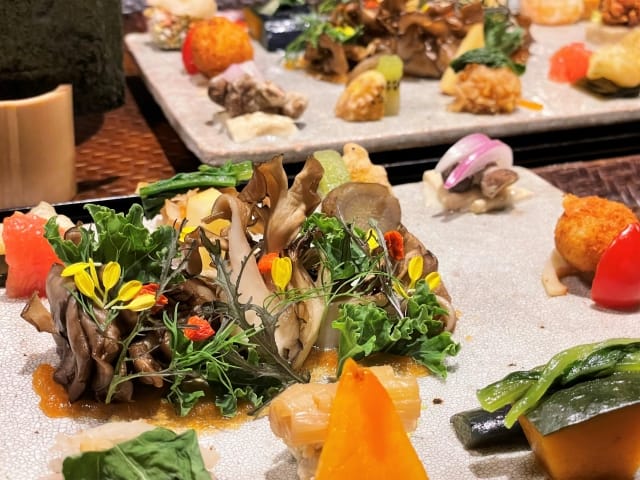
"Kyo Ryouri" is known as high-class cuisine in Kyoto, and its characteristics lie in its delicacy and sense of the seasons. The basic cooking method is simple, maximizing the natural flavors of seasonal ingredients. The emphasis is on bringing out the taste of the ingredients.
Also, Kyo ryouri emphasizes seasonality, with a menu composition that enjoys the taste and colors of ingredients. The local production for local consumption spirit, actively incorporating Kyoto vegetables and Kyoto-produced ingredients, is also unique to Kyo ryouri.
And when it comes to Kyo ryouri, elegant and delicate seasoning and beautiful plating that values harmony with the dishware are important. I think it's an artistic cuisine that showcases the skills and aesthetic sense of the artisans.
When I eat Kyo ryouri, I can't help but be moved by its delicate flavor. From the subtle heat control to the exquisite seasoning and visual beauty, I feel that Kyo ryouri is a cuisine to be enjoyed with all five senses.
However, unlike "obanzai," Kyo ryouri is generally eaten on special occasions like celebrations. It's certainly not a cuisine that can be casually enjoyed. But if you have the chance, please try authentic Kyo ryouri at least once.
Representative Kyo ryouri
Now that you understand the characteristics of Kyo ryouri, let me introduce some representative dishes.
Yudofu
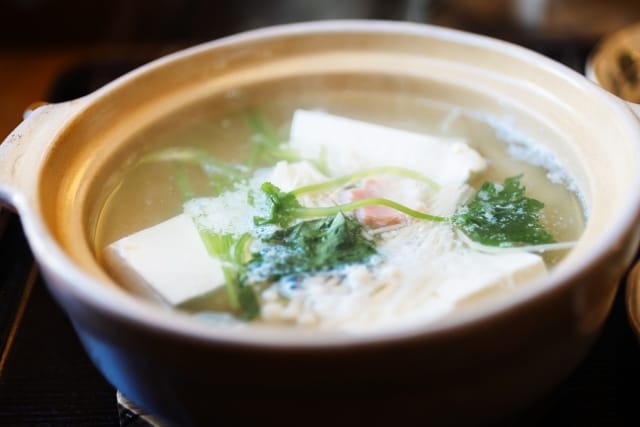
Yudofu is a simple but high-class dish where silken tofu is warmed in hot water and eaten dipped in diluted dashi. It's often served in high-class restaurants in Kyoto.
Warming the tofu in hot water makes it smooth to the palate and brings out the natural sweetness of the tofu. The dashi is carefully made from ingredients like kelp and bonito flakes, resulting in an elegant flavor.
Condiments like wasabi, shichimi togarashi (seven-flavor chili pepper), and green onions are often served with it.
Eating warm yudofu in the cold winter season warms you up from the core of your body. I think it's a representative winter delicacy in Kyoto. Yudofu, with its high-quality tofu and dashi, and simple cooking method, is a dish where you can feel the depth of Kyo ryouri.
Yuba
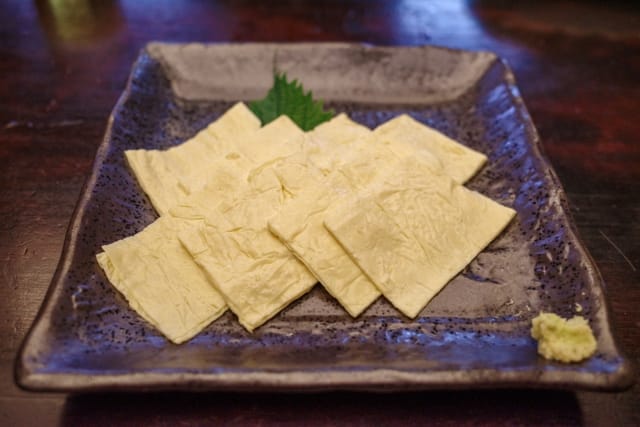
Yuba is a traditional Kyoto dish that looks like thin tofu. You can enjoy yuba itself like sashimi, or yuba can be used as an ingredient in other Kyoto dishes.
It's also often used in dishes for celebratory occasions. Dishes garnished with yuba have a color that makes you feel the arrival of spring and are very beautiful.
Among Kyo ryouri, yuba is an ingredient that stands out for its delicacy. I think it's a special dish where you can feel Kyoto's sense of aesthetics within its simple flavor.
Hamo (Pike Conger) Dishes

Kyoto's hamo dishes involve enjoying hamo, which is in season in summer, in ways such as boiled or as tempura. Hamo is characterized by its mild flavor and elegant texture.
Before eating hamo dishes, first, a technique called honekiri is used to finely cut the bones of the hamo to make it easier to eat. This is a technique that only skilled artisans can do. Hamo that has undergone honekiri is as smooth as fillet meat.
Boiling the hamo brings out its umami and results in a texture with a good bite.
Tempura, where you can enjoy the crispy texture of the batter, is also a staple of hamo dishes. Frying in oil concentrates the umami of the hamo.
In Kyoto, there's a custom of eating hamo dishes during the summer "Gion Festival" season. It's a seasonal delicacy that's indispensable to the summer festival that colors Kyoto. Please try this dish, which particularly represents the summer flavors among Kyo ryouri, during its peak season.
Kaiseki Cuisine
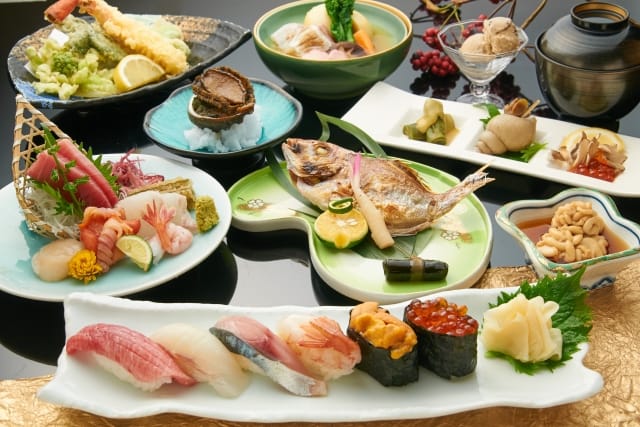
Kaiseki cuisine is a form of Kyo ryouri that originally developed as a meal served at tea ceremony. It's characterized by dishes that use plenty of seasonal ingredients and are visually beautiful.
Currently, it's often served at high-class restaurants, and it's also popular to enjoy with alcohol. Reflecting the tea ceremony, Japanese sweets and matcha are sometimes served at the end of the meal.
I think kaiseki cuisine is particularly formal and artistically high among Kyo ryouris. I believe the essence of kaiseki cuisine is to enjoy it comprehensively, including not just the appearance and taste, but also the flow of the dishes.
Goma Dofu
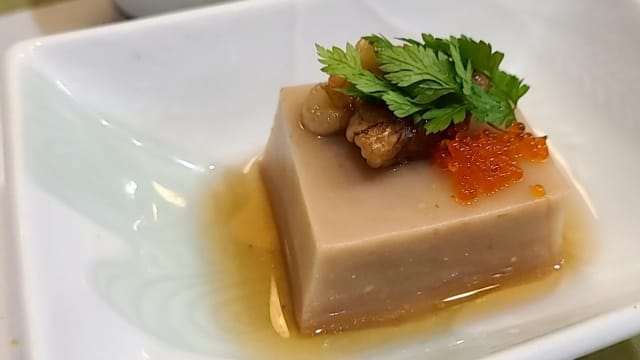
Goma dofu is a Kyoto tofu dish that's rich in sesame flavor, smooth, and creamy. By mashing firm tofu and mixing it with sesame paste, it results in a rich flavor.
The characteristic is the perfect match between the mildness of tofu and the nuttiness of sesame. Although it looks dark, it has a surprisingly light taste.
Goma dofu is popular as an appetizer in Kyo ryouri and as a snack with sake. Despite its rich flavor, it also gives a somewhat healthy impression.
Shops to Enjoy Kyo Ryouri
Since Kyo ryouri is mostly served in high-class restaurants, reservations are usually required. There are few shops you can casually enter. I recommend starting with obanzai to enjoy the taste of Kyoto.
However, if you want to taste authentic Kyo ryouri, I recommend the following shops.
Hassun
Source: Tabelog by Hiro45316
Hassun is known as a famous restaurant for Kyo ryouri. The menu is "omakase" (chef's choice) only, and Kyo ryouri that reflects the changing seasons is served.
The budget is quite high, with lunch costing 10,000-15,000 yen per person and dinner 20,000-30,000 yen, and telephone reservation is required, so I think the hurdle is high. But if you have a Japanese local friend, please try to go together.
When I visited Hassun, the owner was very friendly and taught me a lot about Kyo ryouri. I think I was able to fully enjoy the charm of Kyo ryouri, not only enjoying high-class cuisine but also including such conversations.
<Store Information>
Address: 95-95-4 Sueyoshicho, Higashiyama Ward, Kyoto 605-0085
Closed: Sundays
Phone: 075-561-3984
Hours: 6 PM–9 PM
Website: https://tabelog.com/en/kyoto/A2601/A260301/26002259/
Gion Nishikawa
Source: Tabelog by Gion Nishikawa
Gion Nishikawa is a restaurant where you can enjoy Kyo ryouri centered on kaiseki cuisine. The interior design also has a Japanese feel, so you can experience a Kyoto-like atmosphere.
The lunch budget is 10,000-15,000 yen per person, and dinner is 25,000-35,000 yen, with telephone reservation required.
When I had kaiseki cuisine at Gion Nishikawa, I was moved by its beautiful plating. I also felt the Kyoto-like attention to detail in the selection of ingredients that make you feel the changing seasons.
If you're going to taste high-class Kyo ryouri, it's best to enjoy the atmosphere as well. I think Gion Nishikawa is a shop where you can have exactly such an experience.
<Store Information>
Address: 473 Shimokawaracho, Higashiyama Ward, Kyoto 605-0825
Closed: Sundays
Phone: 075-525-1776
Hours: 12PM–3 PM, 6:30PM–10 PM
Hours (Mondays): 6:30 PM–10 PM
Website: https://gion-nishikawa.co.jp/
Hidden Kyoto Foods Loved by Locals
While Kyo ryouri and obanzai represent Kyoto's food culture, there are many other delicious things in this city.
Here, I'll introduce some hidden Kyoto gourmet foods loved by Kyoto locals. When you visit Kyoto, please try to enjoy these popular flavors as well.
Nishin Soba
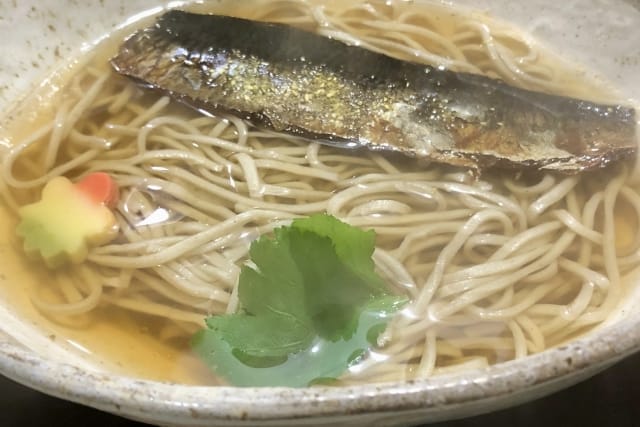
Nishin soba is one of the representative noodle dishes of Kyoto. It's a dish where sweet and savory simmered herring is placed on top of soba noodles.
The characteristic of Kyoto's nishin soba is the use of sweet and savory simmered herring. The dashi is also mainly an elegant flavor using ingredients like kelp and bonito flakes. While there's also nishin soba in Hokkaido, the Kyoto version is characterized by a lighter dashi and sweeter herring.
However, nishin soba is a cold-season dish. Most shops don't serve it in summer, so be aware of this.
Recommended Shop to Taste Nishin Soba in Kyoto: Matsuba
Source: Tabelog by KUISINBOU Samurai
When it comes to nishin soba in Kyoto, "Matsuba" is the first name that comes up. It's a long-established shop with over 150 years of history, known as a famous shop for nishin soba.
Usually, nishin soba is a seasonal menu item limited to winter, but it's nice that you can eat it year-round at Matsuba.
The main shop of Matsuba is easily accessible, just a 1-minute walk from Keihan Gion-Shijo Station and about a 5-minute walk from Kawaramachi Station. There's also a branch inside the Shinkansen ticket gate at Kyoto Station, which is convenient for adjusting time until your Shinkansen departure.
Why not experience Matsuba's nishin soba, a taste of Kyoto breathing with history and tradition, at least once?
<Store Information>
Address: 192 Kawabatacho, Higashiyama Ward, Kyoto, 605-0075
Closed: Closed
Phone: 075-561-1451
Hours: 10:30 AM–8:30 PM
Website: http://www.sobamatsuba.co.jp/
Kyoto Pickles
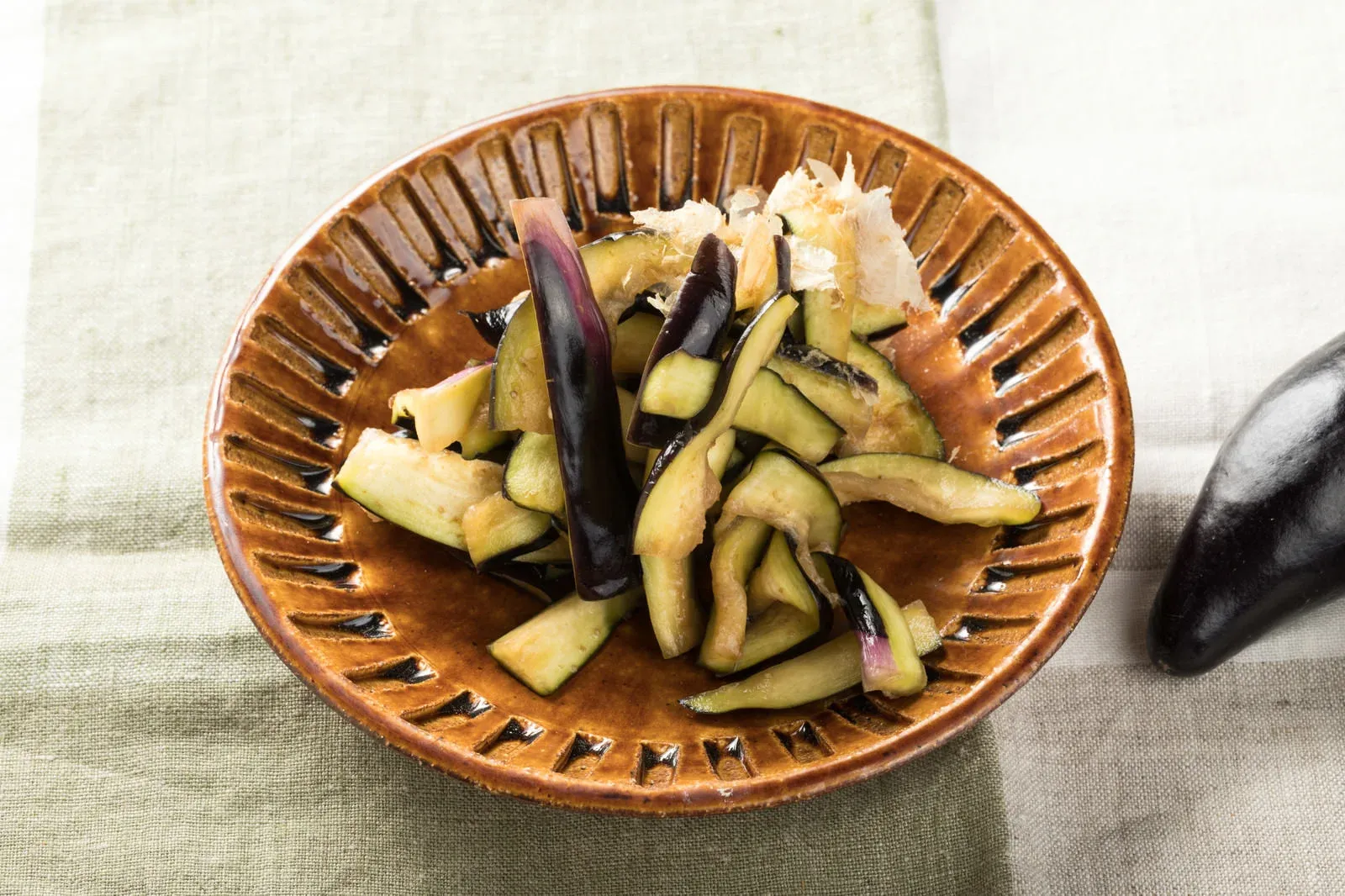
Kyoto pickles (tsukemono) are traditional fermented foods in Kyoto, made using Kyoto vegetables. There are various types of pickles, such as senmaizuke, suguki, and shibazuke.
The characteristics of Kyoto pickles are, above all, their elegant flavor and crisp texture. They're an indispensable supporting role in Kyo ryouri, never missing from breakfasts at ryokan or high-class restaurants. They often appear in obanzai buffets as well.
Also, Kyoto pickles are popular as Kyoto souvenirs, and there are many long-established pickle shops in Kyoto. However, they have a unique taste, so they might be a bit difficult for foreigners to eat. But for Kyoto locals, they're an indispensable and important food, so please try them if you have the chance.
Restaurant to Easily Enjoy Kyoto Pickles: Bubuya
Source: Tabelog by Kiyo0715
Bubuya is a shop where you can enjoy Kyoto-style ochazuke (rice with tea poured over). A plate with many pickles that go well with ochazuke is served, which is characteristic.
The relatively affordable price setting of 1,500-2,000 yen per person is also a nice point. It's right in front of the popular tourist spot Yasaka Shrine, so it's easy to drop by during sightseeing.
When I visited Bubuya, I was impressed by the colorful assortment of Kyoto pickles. Enjoying the flavors of each pickle with ochazuke was a luxurious Kyoto-like time.
<Store Information>
Address: Gion Kawakatsu, 297 Kitagawa, Gionmachi, Higashiyama Ward, Kyoto 605-0073
Closed: Wednesdays
Phone: 075-561-1745
Hours: 11 AM–6 PM
Website: https://gion-kawakatsu.com/
Kyoto Sweets
Source: Tabelog by body pit kyoto
"Kyoto sweets" refer to traditional sweets from Kyoto. They're characterized by their beautiful appearance reflecting the four seasons, truly artistic sweets.
There are many famous sweets unique to Kyoto, such as ajari mochi and nama yatsuhashi. Each has a delicate design and elegant sweetness that reflects the craftsmanship of the artisans.
Also, Kyoto sweets have a deep connection with the tea ceremony. Sweets served at tea ceremonies are also an important genre of Kyoto sweets. The visual beauty and elegant sweetness further enhance the tea.
Kyoto sweets are representative sweets of Kyoto that are welcome as gifts or souvenirs. However, they often have a short shelf life, so they're not suitable as souvenirs for overseas. But please try them during your stay in Kyoto.
Famous Shop for Kyoto Sweet Yatsuhashi: Shogoin
Source: Tabelog by Gossa
When it comes to yatsuhashi in Kyoto, Shogoin is the first name that comes up. It's a shop where you can taste both hard yatsuhashi, which is like a cookie, and nama (fresh) yatsuhashi.
One of the attractions of nama yatsuhashi is that various flavors appear each season. You can enjoy flavors that make you feel the four seasons of Kyoto, such as matcha, cherry blossom, and yuzu. They don't keep for long, but they're sweets I want you to try during your stay in Kyoto.
Also, it's nice that Shogoin has shops in various places in Kyoto city and is often sold in souvenir shops, making it easy to get. Please check it out when sightseeing in Kyoto.
When I first ate Shogoin's yatsuhashi, I was moved by its elegant sweetness. If you want to know the charm of Kyoto sweets, I recommend starting with Shogoin's yatsuhashi.
Website: https://shogoin.co.jp/en/
The Charm of Kyoto's Nishiki Market
Kyoto has markets with a long history that have supported the food culture of Kyoto, located inland. Among them, the famous one is Nishiki Market. It's truly the kitchen of Kyoto, with an abundance of fresh ingredients lined up.
What is Nishiki Market?
Source: Wikipedia
Nishiki Market is the largest market in Kyoto. Fresh seafood, Kyoto vegetables, Japanese sweets, and various ingredients are crammed in.
Nishiki Market, with over 400 years of history, is lined with obanzai, Kyo ryouri restaurants, and souvenir shops. Food for strolling that you can eat on the spot is also very popular in the market.
When I visit Nishiki Market, my purpose is, of course, food strolling. Although it's a traditional market, there's a lot of shop turnover, so it's also a place where I make new discoveries every time I go.
Tours to Fully Enjoy Nishiki Market
Nishiki Market has so many shops that travelers might find it difficult to enjoy efficiently. In such cases, I recommend participating in a tour.
"Nishiki Market Brunch Walking Food Tour" by Magical Trip
This is a tour provided by us at Magical Trip. After exploring Gion, a traditional area of Kyoto, you can enjoy food strolling in Nishiki Market in the morning.
It includes brunch at a restaurant in the market and is affordably priced at about $45. I highly recommend this tour for those who want to efficiently enjoy Nishiki Market.
Click here for more details: Nishiki Market Brunch Walking Food Tour
"Kyoto Nishiki Market Food Tour" by Arigato Travel
This is a tour that explores Nishiki Market, similar to Magical Trip. Unlike the tour introduced earlier, it doesn't go to places other than Nishiki Market.
I think it's a perfect tour for those who want to thoroughly enjoy just Nishiki Market. It's nice that you can efficiently tour the highlights of the market.
Click here for more details: Kyoto Nishiki Market Food Tour
Frequently Asked Questions About Kyoto Food
Finally, I'll answer common questions that foreigners often have about Kyoto food.
How can I casually enjoy Kyoto food?
Authentic restaurants in Kyoto, especially Kyo ryouri restaurants, often require reservations and have a high hurdle. To casually enjoy Kyoto food, I recommend starting with casual obanzai restaurants.
Personally, I think it's best to sample various dishes little by little at obanzai buffets. You should be able to enjoy the homely flavors of Kyoto at reasonable prices.
Also, enjoying food strolling at Nishiki Market using a tour is another method.
What are famous drinks in Kyoto?
When it comes to Kyoto, it's tea. Uji tea is one of the representative drinks of Kyoto. Among them, "matcha" is a taste unique to Kyoto, deeply related to the tea ceremony, characterized by its rich green color and mellow taste.
Also, sake is an important drink in Kyoto. Especially the sake breweries in Fushimi are famous and highly regarded nationwide.
However, my top recommendation is definitely matcha. If you come to Kyoto, I want you to taste authentic matcha at least once.
I hope this article has conveyed even a little of the charm of Kyoto's food culture.
Kyo ryouri, obanzai, nishin soba, Kyoto pickles, Kyoto sweets. Kyoto has many traditional and delicious foods. They all have flavors unique to Kyoto, cultivated over a long history.
There are also many Kyoto foods that can be easily enjoyed, such as obanzai and Nishiki Market gourmet. Please drop by during your sightseeing.
Please use this article to prepare and enjoy your gourmet trip in Kyoto, Japan's traditional city!
If you are interested in Kyoto Best Izakaya & Bars, check the article below! I summarized how and where you can enjoy Kyoto Best Izakaya & Bars as much as possible.
